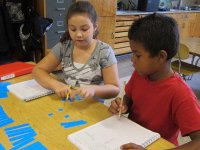Common Core Standard: Third Grade Math Strategies
Your content has been saved!
Go to My Saved Content.CCSS.Math.Content.3.OA.B.5: Apply properties of operations as strategies to multiply and divide.
Most math instruction for younger elementary students (K-2) is based around number sense. Students are given opportunities to compare and contrast numbers, add them up, subtract them, identify place values and solve basic word problems. In third grade, students are asked to apply this knowledge to explore and recognize patterns and relationships between addition, multiplication and division.
Inquiry and Student-Centered Learning
For this standard, the learning goal is for students to understand and apply the distributive, associative and commutative properties of multiplication. In short, students should be able to explain and demonstrate the relationships between multiplication, division and addition.
This standard lends itself to inquiry and student-centered learning, since exploration and pattern recognition can be easily done through discussion between peers. Divide students into groups (heterogeneous or random, no more than four to a group), and give each group a piece of chart paper. Hand an equation to each group (i.e. 8 X 6 = 48) and give them a challenge. Tell each group that they have five minutes to come up with ten different ways to get the answer (in the case of the example, 48) using addition, multiplication and division. Have each group record their equations on the chart paper.
Once time is up (and you can always provide more time if necessary), have students do a gallery walk to view other groups' chart papers. If you have tech available, have students use FastFig or Wolfram Alpha to check their classmates' work. Give each group a feedback paper so that visiting groups can leave corrections there.
After everyone has seen everyone else's work, bring the class back together and discuss the activity. Ask things like "What did you notice?" Ask students to identify their favorite or what they considered the most high-level equation they saw, and have them explain why they chose it.
Alternatively, you could have each group choose a reporter to announce their equations and solicit verbal feedback from the class.
This lesson will require that students have been exposed to both group work and collaboration, and that they have been exposed to this kind of lesson before. It would make sense to first have them practice the three properties of multiplication as a whole class and individually.
Make sure to give students the challenge of finding ten different equations, even if you are sure they will not be able to. This will keep them working more than if you just say "as many as you can." You never know -- you may be pleasantly surprised!
Extra Support
If you know that you have students who struggle with these concepts, it may also be a good idea to intentionally create groups that are as heterogeneous as possible. Make sure to circulate during the activity, listening in on student conversation, asking questions and ensuring that all students get an opportunity to give input and participate. For both special education and ELL students, you may want to prep them for the lesson with extra vocabulary support or by giving them strategies to participate in the group if they have trouble communicating with their peers. For instance, to minimize misunderstandings, have them write down an equation on paper and show it to the group while explaining.
Once students have shown mastery of these concepts, introduce them to a game such as Math 24 (which can also be played online at www.mathplayground.com/make_24.html), and run Math 24 Challenge tournaments in the classroom.
